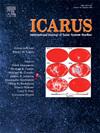Statistics of Saturn's ring occultations: Implications for structure, dynamics, and origins
IF 2.5
2区 物理与天体物理
Q2 ASTRONOMY & ASTROPHYSICS
引用次数: 0
Abstract
The varying geometry of Cassini star occultations by Saturn's rings constrains both the size and shape of structures that block starlight. We extend the approach of Showalter and Nicholson (1990, who first used the observed variance of the stellar counts to calculate the size of the ring particles from the Voyager ring occultation) to higher moments and remove their restrictions on fractional particle area δ < < 1 and line-of-sight optical depth τ < < 1. We calculate the excess variance, skewness and kurtosis including the effects of irregular particle shadows, adopting a rectangular parallelepiped model of self-gravity wakes which can also be extended to model irregularly spaced gaps, ghosts, and clumps. Particles in Saturn's background C ring and the C ring ramp are matched by spheres with effective radius aeff = 2.5 m, with no evidence for gaps or ghosts in these 2 regions. The A ring statistics are dominated by self-gravity wakes. The skewness and kurtosis require transparent regions like those seen in high resolution Cassini occultations and indicated by numerical simulations. Transparent gaps between self-gravity wakes demonstrate dynamic processes which prevent the rings from achieving uniformity. The changing wake structures show density waves can trigger aggregation, consistent with a Predator-Prey model of ring dynamics (Esposito et al. 2012). Perturbed by passing density waves, self-gravity wakes grow and erode on orbital timescales with a full amplitude of 50 %, and a phase lag Δϕ ∼ 60°. We speculate that the collisions or azimuthal instabilities of these wakes may lead to the straw features seen in Cassini images. Ejecta from collisions and erosion may be forming the dusty haloes around the density waves. Similar resonant perturbations from a forming protoplanet could trigger growth at its resonant locations in a debris disk.
求助全文
约1分钟内获得全文
求助全文
来源期刊

Icarus
地学天文-天文与天体物理
CiteScore
6.30
自引率
18.80%
发文量
356
审稿时长
2-4 weeks
期刊介绍:
Icarus is devoted to the publication of original contributions in the field of Solar System studies. Manuscripts reporting the results of new research - observational, experimental, or theoretical - concerning the astronomy, geology, meteorology, physics, chemistry, biology, and other scientific aspects of our Solar System or extrasolar systems are welcome. The journal generally does not publish papers devoted exclusively to the Sun, the Earth, celestial mechanics, meteoritics, or astrophysics. Icarus does not publish papers that provide "improved" versions of Bode''s law, or other numerical relations, without a sound physical basis. Icarus does not publish meeting announcements or general notices. Reviews, historical papers, and manuscripts describing spacecraft instrumentation may be considered, but only with prior approval of the editor. An entire issue of the journal is occasionally devoted to a single subject, usually arising from a conference on the same topic. The language of publication is English. American or British usage is accepted, but not a mixture of these.
 求助内容:
求助内容: 应助结果提醒方式:
应助结果提醒方式:


